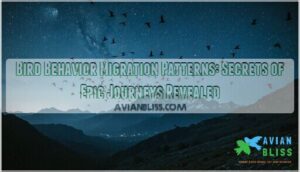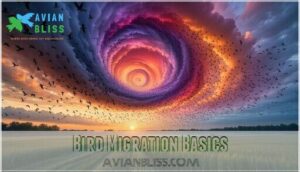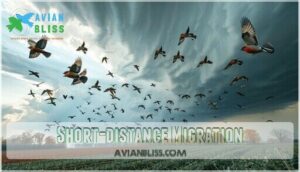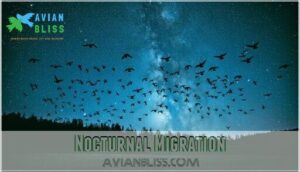This site is supported by our readers. We may earn a commission, at no cost to you, if you purchase through links.

They migrate to find food, avoid harsh weather, and secure safe nesting areas.
Some take short hops between regions, while others undertake jaw-dropping journeys spanning oceans and continents.
They use nature’s GPS—following the sun, stars, Earth’s magnetic fields, and even familiar landmarks.
Many fly at night to save energy and dodge predators, making their treks as efficient as possible.
Migration isn’t just instinct; it’s shaped by genetics, ancient climates, and ongoing environmental changes.
Curious how climate shifts or city lights affect these epic voyages?
There’s much more to uncover about the impact of environmental changes on these migrations.
Table Of Contents
- Key Takeaways
- Bird Migration Basics
- Migration Patterns
- Navigation Methods
- Migration Behavior
- Migration Evolution
- Migration Conservation
- Frequently Asked Questions (FAQs)
- How do birds decide when to migrate?
- What are migratory behaviors?
- What is the migratory theory of birds?
- What is the behavior of birds migrating?
- What are the migration patterns of birds?
- Do migrating birds return to the same place every year?
- Do all birds within a species migrate together?
- What happens when birds get lost during migration?
- How do baby birds learn migration routes?
- Can birds change their traditional migration routes?
- Conclusion
Key Takeaways
- Birds migrate to find food, escape harsh weather, and secure safe nesting sites, with survival driving these movements.
- They use natural navigation tools like the sun, stars, Earth’s magnetic fields, and visual landmarks to complete their journeys.
- Climate change, habitat loss, and artificial structures are major threats, disrupting migration routes and endangering species.
- You can support bird conservation by protecting stopover habitats, reducing light pollution, and backing climate change mitigation efforts to ensure bird conservation and prevent habitat loss.
Bird Migration Basics
Bird migration revolves around three key needs: finding food, avoiding harsh weather, and securing safe nesting sites.
Bird migration thrives on survival instincts—tracking food, escaping harsh climates, and finding perfect nesting sites to ensure their future.
These remarkable journeys are driven by survival instincts, helping birds adapt to seasonal changes and shifting resources, which is guided by the need to find food.
Finding Food Sources
Bird migration is driven by food availability. Birds follow seasonal abundance, utilizing foraging strategies to locate protein-rich insects or calorie-dense food during breeding and feeding seasons.
- Insectivorous species time migration for prey migration, like caterpillars or flies.
- Rest at stopovers offers essential nutrition in nutrient-rich areas.
- Species adapt their diets to shifting food supply trends.
Escaping Harsh Weather
Not every bird flies south just to escape the cold—many tolerate it surprisingly well.
Instead, they rely on weather cues to trigger seasonal movements.
Cold tolerance varies, but declining food availability drives migration timing.
Seeking climate refuges is a pivotal survival strategy.
With seasonal changes worsening due to climate change, migration challenges highlight how birds adapt to guarantee their survival.
Suitable Nesting Sites
Migration often leads to perfect nesting sites, boosting breeding success. Birds prioritize predator-safe nests, ideal nest microclimates, and abundant nesting materials for raising young.
Nest site selection depends on factors like competition and habitat quality. Migration patterns guide birds to thriving breeding grounds, ensuring survival.
Without ideal nesting habitats, they can’t reproduce effectively. Cup nests offer flexibility and protection.
Key considerations include:
- Nest site competition
- Predator-safe nests
- Ideal nest microclimate
- Proximity to food
- Access to nesting materials
Migration Patterns
You’ll find that bird migration patterns vary widely, with some species traveling just a few miles while others cross entire continents.
From short-distance trips to dramatic long-distance journeys, these movements are guided by food availability, weather changes, and survival needs.
Short-distance Migration
Some birds, like robins and waxwings, are short-distance migrants, making seasonal movements within a few hundred miles.
These local movements often help track resources like food or better nesting spots.
Partial migration happens in some species, where only certain individuals relocate, and short trips, highly influenced by weather responses, improve breeding success and reflect fascinating variations in bird behavior and migration patterns, showcasing breeding success.
Long-distance Migration
Long-distance migrants tackle journeys stretching thousands of miles, fueled by physiological adaptations like shrinking organs or doubling weight.
They navigate vast migration routes using bird navigation strategies such as magnetic fields and star maps. Along migration flyways, stopover ecology offers rest and food.
Evolutionary pressures shape route variations, balancing energetic demands with survival. These migration distances stretch nature’s imagination.
Habitat destruction poses a significant threat to these species.
- Examples: Arctic Tern, Bar-tailed Godwit
- Flyways: Pacific, Mississippi, Atlantic
- Strategies: Magnetic fields, celestial cues
- Challenges: Predators, severe weather
Altitudinal Migration
Altitudinal migration is like a vertical commute for birds, especially in mountain habitats.
Species adjust to seasonal shifts, moving to lower altitudes as temperatures drop and resources become scarce.
This bird migration behavior guarantees access to food and nesting sites, and climate effects play a role too, with species examples like robins and thrushes showcasing remarkable adaptation to these unique migration patterns.
Nocturnal Migration
At night, many birds take advantage of cooler air for energy conservation during their journeys.
Nocturnal migration reduces predator threats, allowing safer travel in darkness.
Using sensory adaptations like detecting stars and magnetic fields, they tackle navigation challenges.
Research shows that sleep patterns adjust, letting birds rest during the day, which highlights fascinating bird migration patterns and their impressive survival strategies.
These nighttime migrations are a testament to the birds’ ability to adapt and survive in various environments.
Navigation Methods
You’d be amazed by how birds navigate vast distances with remarkable precision using natural tools.
From reading the sun and stars to detecting Earth’s magnetic fields, they rely on intricate systems you might never expect.
Using The Sun and Stars
Bird navigation methods include using the sun and stars as precise tools for their epic migrations.
Celestial navigation relies on solar compasses and star charting, even adjusting for atmospheric refraction.
Birds track:
- The sun’s angle during diurnal migrations.
- Stars during nocturnal use for navigation.
- Seasonal shifts in star patterns for migration routes.
- Consistent solar paths to optimize bird migration patterns.
Some researchers study celestial navigation products to understand these behaviors.
Detecting Magnetic Fields
Piloting without a GPS? Birds have that covered. Through magnetic field perception and magnetic navigation, they utilize the Earth’s magnetoreception process.
Sensory neurons in their beaks detect iron-based crystals, while cryptochromes in their eyes help them visualize magnetic maps. This incredible adaptation guarantees safe migration, even for first-timers still mastering routes.
Let’s admire their natural compass!
| Feature | Role in Navigation | Example Application |
|---|---|---|
| Magnetic Field Perception | Orientation aid | Identifying migration direction |
| Magnetite Crystals | Locational sensing | Beak-based magnetic cues |
| Cryptochromes | Visual map assistance | North-South positioning |
| Sensory Neurons | Magnetic data reception | Safe course adjustment |
| Magnetic Map Formation | Route memory storage | Enhancing navigational skills |
Visual Landmarks
Beyond magnetic navigation, birds rely heavily on visual landmarks during migration.
You’ll find they develop remarkable landmark recognition skills, mentally mapping terrain features like mountains, rivers, and coastlines.
These visual cues serve as road signs on their migration routes, helping with obstacle avoidance and habitat awareness.
Research shows experienced migrants can memorize entire landscapes, following the same path year after year with astonishing precision—a natural GPS system that complements their other navigational skills.
Observing a bird’s distinctive head markings can also help identify species during these journeys.
Keen Sense of Smell
While visual landmarks guide many species, the keen sense of smell plays a surprisingly sophisticated role in avian migration behavior.
You’ll find certain migratory bird species can detect specific scents across vast distances, helping them navigate familiar bird migration routes.
- Seabirds like albatrosses use olfactory navigation to detect dimethyl sulfide released by plankton
- Migratory birds can smell rainfall thousands of miles away
- Some species identify their nesting sites through distinct colony odors
- Food source location often relies on scent detection during migration
- Individual variation in smell sensitivity exists across different bird families
Migration Behavior
You’ll observe distinct behavioral adaptations when birds set out on their migratory journeys, including male-led formations, energy-efficient nighttime travel, and strategic predator avoidance tactics.
Male birds lead migrations, showcasing adaptive strategies like nocturnal travel and predator avoidance to ensure survival and breeding success.
These specialized behaviors have evolved over thousands of years, enabling birds to successfully navigate their epic seasonal movements across continents and oceans, which is a result of thousands of years of evolution.
Male Birds Leading The Way
Leadership in avian migration behavior often falls to male birds. You’ll notice adult males arrive ahead of females to establish territories first, giving them a mate selection advantage.
In many migratory bird species, male parents guide young birds during their initial journeys, demonstrating vital navigation skills.
Notably, male-female migration differences are evolving – males are adjusting their arrival dates faster than females, while breeding males typically depart before females or juveniles, balancing predator avoidance role with resource scouting impact.
Night Migration for Energy Efficiency
While male birds often take the lead in migration journeys, the timing of travel is equally strategic.
You’ll find many species fly at night for energy efficiency during bird migration.
Cooler temperatures and calmer air currents reduce water loss and provide thermal benefits.
Darkness offers predator avoidance benefits too, while birds’ remarkable sensory adaptations help them navigate after sunset.
This nocturnal strategy contrasts sharply with diurnal migration patterns seen in other species.
Many species also rely on celestial navigation using stars and moonlight to aid in their migration journeys.
Avoiding Predators
While night flying helps birds save energy, it serves another purpose: protection from predators.
During migration, birds utilize several predator avoidance strategies.
You’ll notice they often select safe stopover sites with adequate cover and food resources.
Group migration defense works effectively too—birds traveling together have more eyes watching for threats.
Many species employ camouflage techniques when resting, blending perfectly with their surroundings.
These migration patterns aren’t just about efficiency; they’re survival strategies in action.
Migration Evolution
You’ll discover that bird migration evolved from tropical ancestors gradually expanding northward to exploit seasonal food abundance and longer daylight hours.
Your understanding of these magnificent journeys will deepen when you consider how genetic programming and environmental triggers have shaped these patterns over thousands of years.
Tropical Ancestors
Behind today’s diverse bird migration patterns lies a fascinating tropical origin story. Most migratory birds we observe evolved from ancestors that inhabited warm, tropical climates before dispersing northward.
- Northward dispersal occurred as birds sought seasonal abundance in temperate regions
- Ancestral habitats provided the genetic legacy for migration behaviors
- Evolutionary pressures selected for birds that could exploit distant resources
- Tropical origins explain why migratory birds return south in winter
- Neotropical migratory birds retain adaptations from their ancestral homes
The key to understanding these patterns is recognizing how evolutionary pressures have shaped the behaviors of migratory birds over time, influencing their decision to migrate and the routes they take.
Genetic Influences
In spite of appearances, a bird’s migratory journey is deeply rooted in its DNA.
You’ll find that genetic factors directly shape these epic travels, with first-time solo migrants relying heavily on inherited navigation skills.
Migratory tendencies pass from parents to offspring, creating distinct behaviors between populations.
This genetic programming influences everything from physiological adaptations to timing mechanisms.
Scientists studying Zugunruhe genetics have discovered that even captive birds display migratory restlessness when their wild counterparts begin seasonal journeys.
These patterns highlight how migration timing differences can isolate bird populations, showcasing the impact of genetic factors on their behavior.
Glacial Retreat Theory
While genetic factors shape migratory behaviors, the Glacial Retreat Theory offers another fascinating dimension to migration evolution.
As massive ice sheets receded roughly 10,000 years ago, birds gradually expanded their ranges northward, following newly available habitats.
This Ice Age Origins theory explains why many species developed seasonal bird migration patterns—evolutionary pressures encouraged birds to exploit summer breeding grounds while maintaining winter refuges.
Bird migration ecology continues to evolve today as climate change alters these ancient migration timelines.
Migration Conservation
You play a pivotal role in protecting migratory birds, whose journeys are threatened by habitat loss, pollution, and climate change.
By understanding these challenges and supporting conservation efforts, you can help guarantee their survival and the health of ecosystems they sustain.
Habitat Loss and Fragmentation
Habitat loss and fragmentation can disrupt bird migration by turning vast landscapes into isolated patches.
Birds struggle to find stopover habitats or safe corridors. This leads to population drops due to edge effects and limited resources.
Support bird conservation with these strategies:
- Protect critical stopover habitats.
- Promote habitat corridors.
- Minimize edge effects.
- Restore degraded bird migration habitats.
Hunting and Pollution
Hunting impacts and pollution are big bird threats.
Lead poisoning from ammo, pesticides harming food sources, and plastic ingestion all endanger species.
Habitat degradation worsens survival odds for migrants.
Here’s how it breaks down:
| Threat | Impact on Birds |
|---|---|
| Hunting | Population decline |
| Lead Poisoning | Organ failure |
| Pesticides | Food source depletion |
| Plastic Ingestion | Internal injuries |
| Habitat Degradation | Loss of nesting areas |
Collisions With Man-made Structures
Man-made structures like tall buildings, communication towers, and windows create collision hazards for migrating birds.
Light pollution and window reflections confuse them during flight, leading to fatal impacts.
To reduce migration hazards, consider these mitigation strategies:
- Install bird-safe Building Design features.
- Minimize unnecessary lighting.
- Use window treatments to reduce reflections.
- Place towers away from key migration routes to reduce fatal impacts.
Climate Change Impacts
Climate change is reshaping bird migration patterns.
Shifting ranges and habitat changes force species to adapt, often unsuccessfully. Mismatched timing disrupts feeding and breeding cycles, while extreme weather makes migration more perilous.
Bird migration trends show species decline as warmer climates alter ecosystems. These impacts challenge survival, highlighting the urgent need to address the climate crisis for migratory birds’ future, which is critical for their future.
Conservation Efforts
Protecting migratory birds takes teamwork and smart conservation actions.
From restoring habitats to setting hunting regulations, every effort counts.
Migration conservation efforts focus on:
- Habitat Restoration: Rebuilding natural nesting and feeding areas.
- Protected Areas: Reserved spaces for safe stops.
- Pollution Reduction: Clean air, land, and water.
- Hunting Regulations: Policies to prevent over-harvesting.
- Climate Mitigation: Slowing warming trends to stabilize ecosystems.
These projects often require specialized habitat repair equipment.
Conservation guarantees birds keep soaring!
Frequently Asked Questions (FAQs)
How do birds decide when to migrate?
Birds "know" it’s time to migrate when days shorten, temperatures drop, or food supply dwindles.
Their internal clocks, guided by environmental cues like sunlight and weather changes, trigger instincts to pack up and fly elsewhere, following their natural instinct to migrate based on these environmental cues.
What are migratory behaviors?
Migratory behaviors include seasonal movement, fueled by the search for food, nesting sites, and survival.
Birds rely on instincts, environmental cues like daylight and temperature, and navigation tools like stars and Earth’s magnetic fields.
What is the migratory theory of birds?
The migratory theory of birds suggests their seasonal movements evolved to seek food, breeding sites, or favorable conditions.
Environmental cues like daylight, temperature, and food availability trigger these instinctive journeys, ensuring survival and reproduction.
What is the behavior of birds migrating?
Migrating birds often fly in flocks for safety, using landmarks, stars, and Earth’s magnetic field for navigation.
They rest at stopover sites to refuel and follow seasonal cues like day length and temperature changes.
What are the migration patterns of birds?
Migration patterns vary widely.
Some birds travel short distances, like robins shifting elevations, while others, like geese, cover thousands of miles.
Routes depend on food, seasons, and innate instincts guiding them safely home.
Do migrating birds return to the same place every year?
Like a traveler with a favorite destination, many migratory birds return to the same spots annually, guided by memory, magnetic fields, and environmental cues.
This loyalty helps them find familiar nesting sites and food sources.
Do all birds within a species migrate together?
Not all birds in a species migrate together.
Some might leave early, while others lag behind.
Factors like age, health, and environmental cues play a role.
It’s like nature’s staggered boarding for their great journey!
What happens when birds get lost during migration?
Getting lost during migration might seem like nature’s GPS glitch, but birds rely on instincts, magnetic fields, and landmarks.
Most adapt, finding food, shelter, or rejoining others through innate navigation skills and environmental cues.
How do baby birds learn migration routes?
Young birds often inherit migration routes instinctively through genetics, while others learn by following experienced adults.
They also use environmental cues like stars, landmarks, and Earth’s magnetic field to navigate, adapting their skills with each journey, guided by instinctively learned behaviors.
Can birds change their traditional migration routes?
Yes, they can! Birds adapt their migration routes due to climate shifts, habitat changes, or food scarcity.
They rely on flexible navigation, innate instincts, and learned behavior to find safer, resource-rich paths over time, utilizing their ability to adapt with innate instincts.
Conclusion
As the adage goes, "Knowledge is power."
Understanding bird behavior migration patterns reveals the intricate balance birds maintain with nature.
Their reliance on diverse navigation methods and survival strategies underscores their adaptability to environmental challenges.
However, threats like habitat loss and climate change demand your attention.
By learning more and supporting conservation efforts, you can help protect these astonishing travelers.
Remember, these epic migrations connect ecosystems across the planet, highlighting the important role birds play in our world, and the need for conservation efforts.















